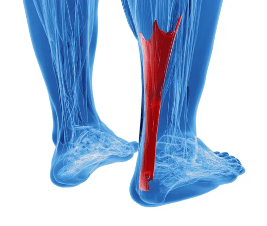All You Need to Know About Achilles Tendonitis

If you never had to read Homer’s Iliad in high school, you at least know vaguely of the story of Achilles. It’s pretty fascinating that an epic poem written in Ancient Greece in the 8th century BC still has a lasting impact. Even in the medical world, this poem is well discussed – at least in terms of the Achilles tendon. The Achilles tendon, the band of tissue that connects calf muscles at the back of the lower leg to your heel bone, was named after Achilles’ unfortunate fate during the Trojan War: an arrow to the back of the heel. This tendon is the largest and strongest tendon in the body and is used when you walk, run and jump. But even though it is powerful and large, it is often seen as a weak spot on the human body because of its namesake and and how often it occurs.
Achilles Tendonitis is a very common condition, most commonly happening to athletes, young and old. In fact, 80% of Achilles tendon ruptures occur during sports or physical activity. Because of how common this condition is, we thought we’d dive deep into it. Let’s take a look at what it is, how it most often happens, sport-related injuries, risk factors and treatment options.
What is Achilles Tendonitis?
As mentioned, Achilles tendonitis is a common condition that causes pain along the back of the leg near the heel. Achilles tendonitis is an overuse injury of the Achilles tendon. During tendonitis, this tendon can become swollen, making it hard to move, walk or shift the leg as you normally might.
The Symptoms
In order to be diagnosed with Achilles tendonitis, there are some common symptoms that you may want to look out for. Typical symptoms often include:
- Dull pain at the back of the leg
- Stiffness along the Achilles tendon, especially in the morning or after waking up from sleep
- Pain getting worse after continued activity
- Severe pain the day after exercise occurs
- Thickening or visual swelling of the Achilles tendon
- Bone spurs or heel spurs, which are bony projections that develop along bone edges
How does it occur?
When it comes to Achilles Tendonitis, there are several ways it can happen. As mentioned, it is much more common in athletes than in non-athletes. Let’s take a look at the most common sports where it occurs:
- Running
- Tennis
- Basketball
- Soccer
- Volleyball
- Football
- Track and field
- And more
Within these sports, and even outside of these sports, Achilles tendonitis is usually caused by a sudden change in exercise. This might be a sudden increase in movement or even a sudden decrease in typical day-to-day activity. Besides a sudden change, it can also be caused by overuse (such as repetition of the same movements over and over) or degeneration, which occurs when the Achilles tendon is ruptured several times over. In this case, the condition is degeneration of the Achilles tendon. Basically, the condition occurs when very small tears form, and inflammation begins within the Achilles tendon.
Sports-related Achilles Tendonitis is most common
Sports-related injuries are extremely common in adults, teens, and children. Over 3.5 million children and teens are injured as part of organized sports or physical activity each year, according to Stanford Children’s Health. According to the CDC, an average annual estimate of 8.6 million sports- and recreation-related injury episodes were reported, with the majority of these injuries being men. When it comes to Achilles tendonitis, 80% of Achilles tendon ruptures occur during sports or physical activity. When it comes to treating children and teens who are suffering from a sports related injury, age always needs to be taken into consideration.
Children and young teenagers are constantly growing, and their bodies are changing, so their injuries must be treated in a way that won’t negatively impact their growth plate and joints or prevent their bodies from growing in a healthy and natural way. Take this into consideration when your child is dealing with Achilles tendonitis, because treatment options and risk factors may vary exponentially.
Diagnosis
In order to be diagnosed, your doctor will need you to come in to conduct a physical exam. In this physical exam, your doctor will press gently on the tendon to understand the location of pain, tenderness or swelling. Through this process, they will take note of the flexibility, alignment, range of motion and reflexes within your ankle and foot in order to determine the severity of your injury. Within this exam, your doctor may also want to order one or more of the following tests to assess your condition and gather more information:
- X-rays: While an x-ray actually can’t visualize soft tissues such as tendons, they can be used to make sure your injury isn’t dealing with any of the nearby bones.
- Ultrasound: Unlike an ex-ray, ultrasounds can see the soft tissues and tendons within the body and use sound waves to do so. This machine can also be used to see the Achilles tendon in motion, along with the color-Doppler ultrasound that can evaluate the blood flow around the tendon.
- Magnetic resonance imaging (most commonly known as an MRI): MRIs use radio waves and a strong magnet to produce very detailed images of the tissues and tendons, just like the Achilles tendon.
Risk factors
When it comes to the risk of Achilles tendonitis, there are a number of factors that may increase your chances:
- Your sex: As mentioned before, it occurs in men more than women.
- Age: It is most common in adults 30 to 50 years old but can definitely still occur in older and younger patients.
- Physical problems: Some physical features can increase your chances of the condition occurring including a naturally flat arch in your foot, obesity, or unusually tight calf muscles.
- Issues with your athletic and active wear: If you are not wearing appropriate shoes for your athletic activity, it can cause problems. Running or being active in worn out shoes can increase your risk of damaging the Achilles tendon, and not wearing warm enough clothing in cold weather can also negatively impact your muscles.
- Medical history or previous conditions: If you have psoriasis or high blood pressure, you are at a higher risk of developing Achilles tendonitis.
- Medications you are on: Certain medication fluoroquinolone, which are a type of antibiotics, have been associated with higher rates of Achilles tendinitis.
Prevention
While you can’t always prevent injuries like Achilles tendonitis, there are some things you can do that will help you reduce your overall risk:
- Gradually increase or decrease your level of activity: Instead of a sudden change in activity, always try to gradually change your level of activity, whether you will be more or less active. This can prevent a sudden strain, along with warming up before working out and stretching after.
- Wear the right athletic wear: As mentioned, your shoes and other athletic wear play a very big part in how your body handles your physical activity. Make sure that the clothing and shoes you wear are not worn out and that you are preparing your body as best as you can.
- Stretching and strengthening: Before and after working out, you should always stretch your body in order to cool it off. Specifically strengthening your calf muscles can help your Achilles tendon to better handle the stresses of physical activity.
Treatment options
In terms of treatment, there are often non-surgical and surgical treatments options available. These treatment options will range based on the severity of your injury, your medical history, your age, and other factors that your doctor will consider. Most commonly, unless this is a repeated offense, your doctor will recommend you start with nonsurgical treatment. If this does not work, then they will recommend that you progress to considering surgical treatment options. Usually, this is recommended for patients who have experienced Achilles tendonitis more than once.
Non-surgical treatment
Most of the time, your doctor will start you off with non-surgical treatment. Here are some of the non-surgical treatment options that might be recommend to you by your doctor, whether they are paired together or suggested to be done alone:
- RICE: The RICE method is usually recommended for all kinds of injuries, especially sports related injuries. RICE stands for: rest, ice, compression, and elevation. This means that your doctor will expect you to halt your usual physical activity, ask you to ice your affected area often, compress your affected area with the use of an athletic wrap or surgical tape, and elevate your affected area in order to reduce swelling. This is usually the first step in recovery. If it doesn’t do the trick, your doctor will move you on to the next step.
- Protection of the tendon: Depending on the severity of your injury, your doctor may recommend that you take specific efforts in order to protect your tendon for the next few weeks. This may just be a change in footwear, like purchasing better or newer running shoes, the insertion of heel lifts or even the creation of custom orthotics. Your doctor may also recommend that you do not walk barefoot at any point, so your Achilles tendon is supported as it heals. If your condition is severe enough, your doctor might recommend the use of a splint, walking boot or walking cast.
- Medication: Either in combination with another treatment or on its own, your doctor may prescribe you some pain medication. This typically is nonsteroidal anti-inflammatory drugs (NSAIDs) like ibuprofen. It is not recommended that patients take any medication for more than one month without talking to your provider.
- Tendon exercises: If your condition is not severe, your doctor may recommend some specific tendon exercises for you to do at home. These exercises will help heal your tendon through motion.
- Physical therapy: If exercises are necessary but your condition is severe, physical therapy may be the best route for you. At physical therapy, a professional can walk you through the best stretches and movements for your body and your specific condition’s severity.
Surgical treatments options
If the damage to your Achilles tendon is severe enough, you may be led to surgical treatment options. This is especially true if you have had Achilles tendonitis more than once, or if you have been feeling pain for over six months. Here are some of the most common surgical treatment options:
- Gastrocnemius recession: Gastrocnemius recession is a treatment option that works to lengthen the muscles and tendons at the back of the leg which allows the heel to shift downward into a more natural position, rather than be strained. Previously, Percutaneous Tendo-Achilles Lengthening had been recommended, but was found to permanently weaken the Achilles tendon, which gastrocnemius recession does not.
- Debridement and repair: During an Achilles tendon debridement, the tendon is removed off the heel bone and the damaged tissue in the area is removed. Then, the remaining healthy tendon can be stitched back together. This can only be done if there is enough healthy tendon leftover.
- Debridement and tendon transfer: If there is not enough healthy tendon in order to do a debridement and repair, or more than half is damaged, then a tendon transfer will be needed. This option will not hinder your ability to walk, run and love, but may hinder your ability to return back to your sport.
- Ultrasound guided techniques: Sometimes, doctors will offer ultrasound guided surgical approaches for Achilles tendonitis. These options use high velocity saline to break up scar tissue in the tendon, effectively removing unhealthy portions of the tendon.
Dealing with Achilles tendonitis? Need some help figuring out your next step? Schedule an appointment with Integrated Orthopedics today.
